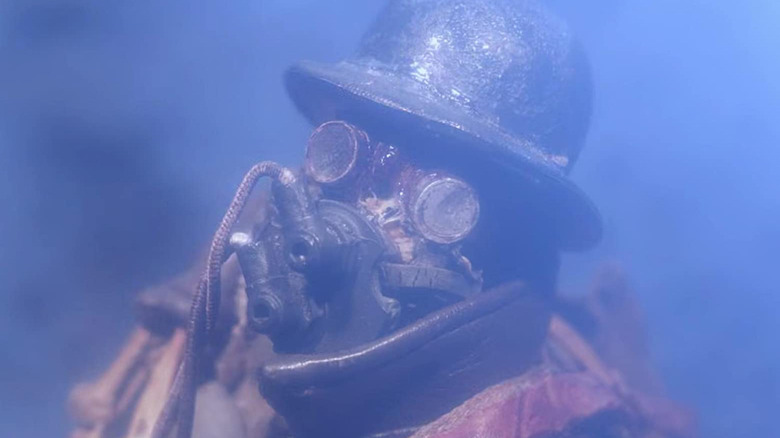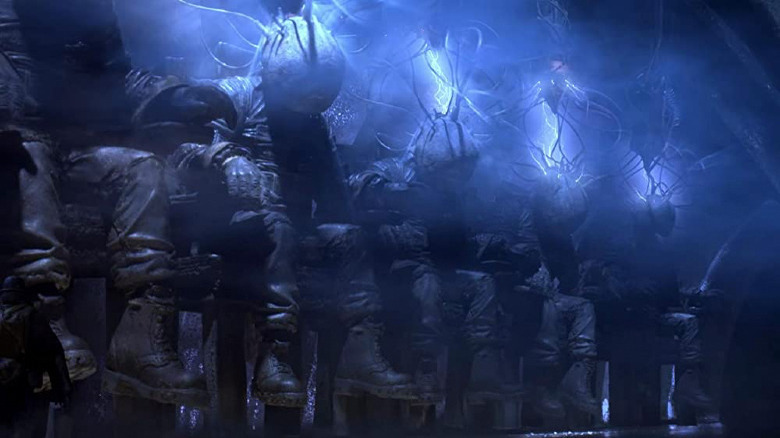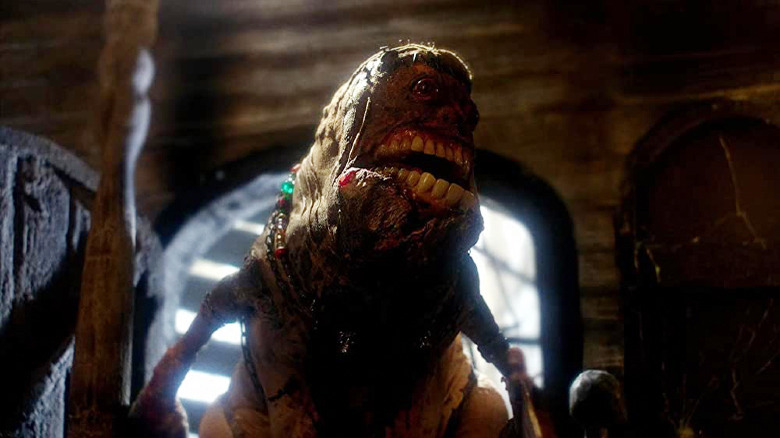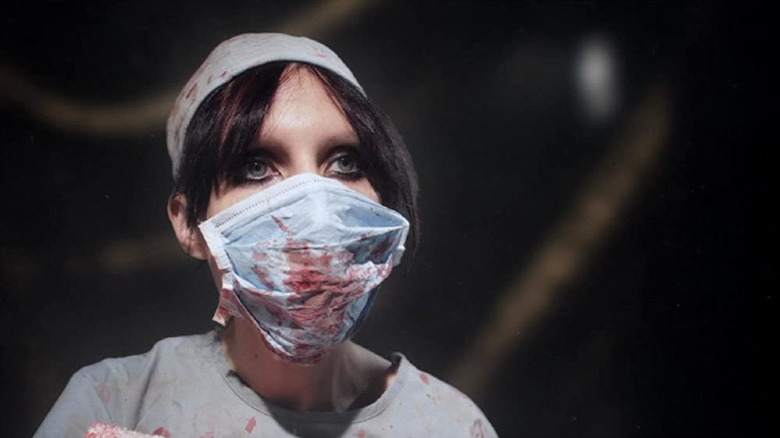The Daily Stream: Mad God Finds The Beauty In The Horror Of Existence
(Welcome to The Daily Stream, an ongoing series in which the /Film team shares what they've been watching, why it's worth checking out, and where you can stream it.)
The Movie: "Mad God"
Where You Can Stream It: Shudder/AMC+
The Pitch: Phil Tippett is the maker of cinematic dreams. An expert in the field of stop-motion, Tippett was hired by George Lucas in the late 1970s to design the Holochess scene for 1977's "Star Wars: A New Hope." Tippett would go on to spend the next 45 years bringing all sorts of entities to life on film, including the flesh-eating stars of Joe Dante's "Piranha," the fire-breathing Vermithrax Pejorative in Matthew Robbins's "Dragonslayer," and the murderous ED-209 in Paul Verhoeven's "RoboCop."
Even after the CGI boom of the early '90s, Tippett adapted to the times. This began with "Jurassic Park," on which Tippett is cheekily credited as a "dinosaur supervisor" for the role he played in crafting the digital dinosaurs of Steven Spielberg's film. He and the artists at his VFX company Tippett Studio (founded in 1984) would later design the not-so-friendly extra-terrestrials of Verhoeven's "Starship Troopers" and Ivan Reitman's "Evolution." They also contributed to the visual effects needed to realize the vampires from the "Twilight" movies in their blood-thirsty state.
Tippett's onscreen legacy is one of goo, guts, and monsters — both the organic and synthetic varieties. While working on Irvin Kershner's "RoboCop 2" in the late '80s, Tippett began directing a stop-motion animated film that would embody these qualities. He wound up spending 20 years writing its script during his free evenings and days off before using what little test footage he had to launch a series of crowd-funding campaigns in the 2010s. The final product, "Mad God," is a film that unquestionably lives up to its name.
Why it's essential viewing
"Mad God" opens with a quote from the Book of Leviticus that speaks of a god unleashing "wrathful hostility" upon those who "disobey Me and remain hostile to Me." A figure clad in a leather jacket, goggles, helmet, a WWI-style gas mask, and gear straps steadily descends in a rusty diving bell into the lower depths of a hellish world. As they journey across the realm, they pause every so often to inspect a map that leads to ... something. (A treasure? A place? A person?) Each time they do, more and more pieces of the map crumble away. Eventually, the traveler discards the final piece of parchment with little fanfare.
The setting of "Mad God" feels like it could have been the brainchild of David Cronenberg, Terry Gilliam, and David Lynch. It's a post-industrial hellscape where fuzzy, featureless drones shamble about, only for many of them to wind up being casually flattened by a steam roller or crushed by one of the giant silver monoliths they spend endless hours building. The traveler comes across such sights as a hotel where a figure bangs away at a piano, all while a giggling woman is repeatedly stabbed one room over. Another location houses a terrified simian strapped atop a surgical table as a shiny, doll-like figurine sits and, um, pleasures itself in the corner. Elsewhere, giant faceless bodies are electrocuted and gradually liquified, the pus dribbling into the gaping mouth of a creature whose organs appear to have fused with the machinery that powers this world.
"Relatable content," as the kids say.
I'm beginnin' to feel like a Mad God, Mad God
In an interview with /Film timed to coincide with the movie's arrival on Shudder, Phil Tippett referred to "Mad God" as "a poetic interpretation or a collage of the world we live in today." Much like our modern capitalistic dystopia, workers are pushed to the brink of exhaustion and readily sacrificed to serve the whims of their overlords in the film (beings represented on huge TV screens in the form of a mouth filled with grime-covered teeth that spouts literal baby babble). Workers' physical bodies and other bio-organic materials are sliced into pieces, melted down, and repurposed to fuel this horrific cycle of creation. It recalls how sensationalist news reports and even beloved pop culture are regurgitated and repackaged to keep the masses in line.
"Mad God" overloads your senses with its visual details and ideas, so much so it's easy to overlook its subtler qualities, like the meticulous sound design by Richard Beggs ("Apocalypse Now"). It's the movie's absurdist sense of humor that prevents the existential horror of it all from becoming overwhelming, in the same way Charlie Chaplin's "Modern Times" offsets its razor-sharp satire of the American Dream with slapstick and sentiment. One could also read "Mad God" as an allegory for its own genesis and the very act of artistic expression, its startling imagery serving as metaphors for the highs and lows of Tippett's 30-year process. "I burned myself out doing this project. So you can call it a religious transformation," as Tippett put it.
Just as "Mad God" never tells us where the traveler's map leads, Tippett suggested the film's true meaning is unfixed and open to interpretation. "Art should be about nothing and let the observer, just like in life, fill in the meaning."
The horror and the wild of stop-motion
Although it bowed on the film festival circuit back in 2021, "Mad God" had the fortune of making its streaming debut in a touchstone year for stop-motion animation. As with Henry Selick's "Wendell & Wild" and Guillermo del Toro and Mark Gustafson's "Pinocchio," Phil Tippett's magnum opus just wouldn't have the same impact if it were made any other way. Its nightmarish visuals require a level of tactility that CGI simply can't achieve and shouldn't have to (but that's a discussion for another day). The crud, dust, gunk, and many bodily fluids that spray the frame throughout the film similarly call for a hyperreal quality to match the story's dream-like logic.
"The Chicago Sun-Times film critic Roger Ebert once wrote this great line that encapsulates everything," Tippett told Inverse in October 2021. "It was that 'computer graphics look real but feel fake, and stop-motion animation looks fake but feels real.'"
A strange beauty emerges from the awe-inspiring stop-motion grotesqueries put to screen in "Mad God." They afford one a fresh perspective on the disgusting yet banal elements of everyday life. Thinking about the sheer amount of waste we produce, reshape, and then re-consume daily might leave one feeling queasy at first. Yet, if you sit with these thoughts long enough (as Tippett's film encourages you to), you may start to see that same beauty in the horror and the wild of our own lives.
Perhaps that's the true power of the film. By employing animation to magnify the sheer grossness of existence, "Mad God" allows us to see the world around us for what it really is and even find meaning in its chaos. For me, this gives the movie an almost spiritual quality. It's certainly not an experience one can easily shake.



